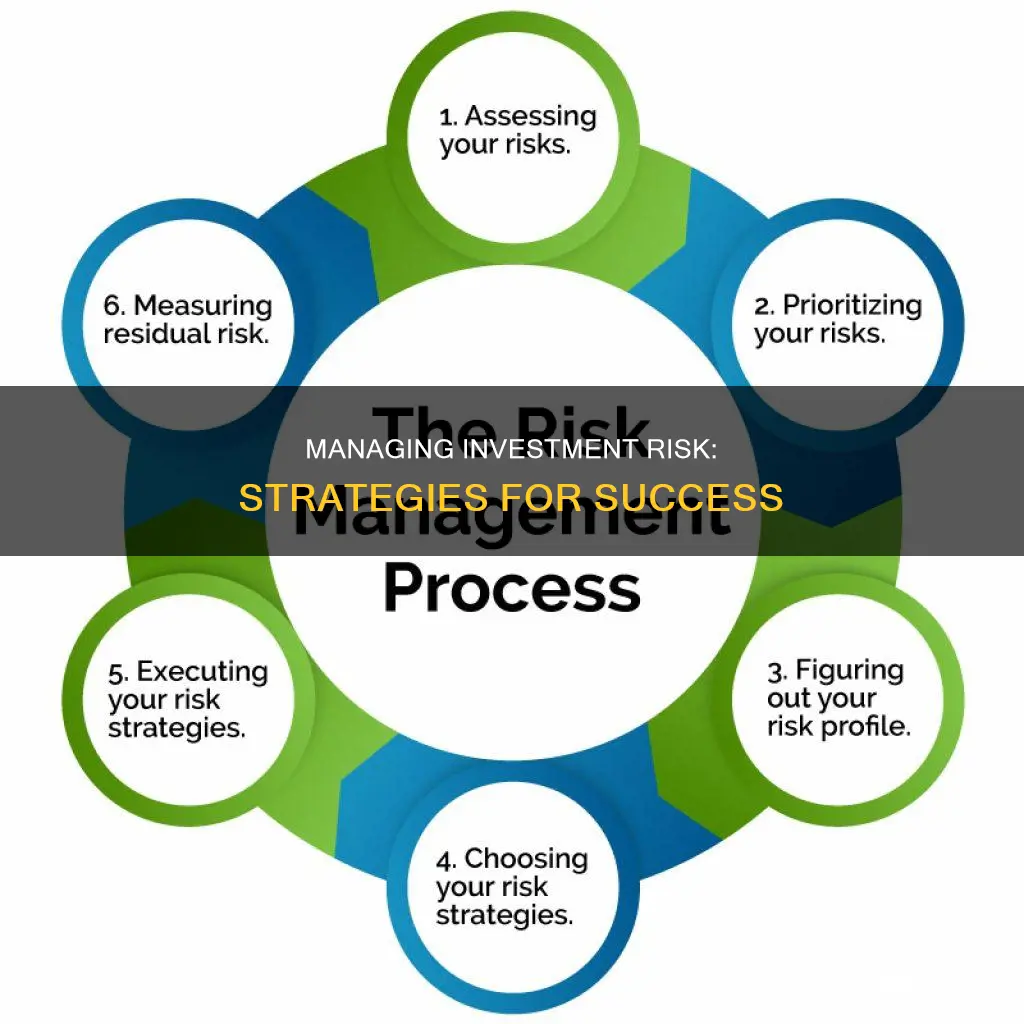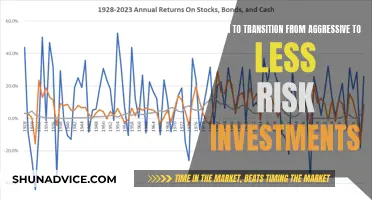
Managing investment risk is a crucial aspect of financial planning, helping investors achieve their goals while mitigating potential losses. It involves identifying and analysing the risks associated with different investment decisions and determining how to address them. This process requires a prudent balance between potential risks and potential rewards, and it is an ongoing endeavour as risks can evolve over time. Here are some strategies to effectively manage investment risk.
| Characteristics | Values |
|---|---|
| Risk measurement | Standard deviation, Sharpe ratio, beta, Value at Risk (VaR), Conditional Value at Risk (CVaR), R-squared |
| Risk assessment | Identifying, analyzing and prioritizing risks; determining impact and mitigation strategies |
| Risk management strategies | Avoidance, retention, sharing, transferring, loss prevention and reduction |
| Risk types | Systematic risk, unsystematic risk, business risk, operational risk, credit/default risk, country risk, foreign-exchange risk, interest rate risk, reinvestment risk, political risk, counterparty risk, liquidity risk, model risk |
What You'll Learn

Diversify your investments
Diversifying your investments is a crucial aspect of managing investment risk. Here are some detailed guidelines and insights on how to effectively diversify your portfolio:
Understanding Diversification
Diversification is a strategy that involves spreading your investments across various assets, industries, and sectors to reduce risk. By not putting "all your eggs in one basket," you lower the chances of experiencing a substantial loss. This strategy is based on the idea that different investments will perform differently over time, with some doing well while others may struggle. By diversifying, you aim to offset potential losses in one area with gains in another.
Asset Allocation
Asset allocation is a key component of diversification. It refers to the way you distribute your investments across different asset classes, such as stocks, bonds, alternative investments, and cash. When allocating your assets, consider your financial goals, risk tolerance, tax situation, and investment timeframe. For example, if you are pursuing growth and are willing to take on market risk, you may allocate 80% of your assets to stocks and 20% to bonds.
Industry and Sector Diversification
Diversifying across multiple industries and sectors is essential. By investing in different industries, you reduce the risk associated with any single industry or sector. For instance, if you invest in multiple stocks from diverse industries, you lower the impact of negative performance in any one company or industry. This approach is often referred to as "don't put all your eggs in one basket."
Geographic Diversification
In addition to industry and sector diversification, consider spreading your investments across different geographic regions and countries. This type of diversification helps protect your portfolio from country-specific or regional economic downturns, political events, or market fluctuations. By investing globally, you increase your exposure to different markets and potentially reduce the impact of localised risks.
Regular Review and Rebalancing
Diversification is an ongoing process. Markets and economies change, and so do the performance and risk profiles of different investments. Therefore, it's crucial to regularly review and rebalance your portfolio. Monitor your investments and make adjustments as necessary to ensure your portfolio remains aligned with your risk tolerance and financial goals. This proactive approach helps you stay on top of market trends and adjust your strategy accordingly.
Limitations of Diversification
While diversification is a powerful risk management tool, it's important to recognise its limitations. Diversification does not guarantee profit or eliminate risk entirely. It is a strategy to manage and reduce risk, but it does not completely remove it. There is still a possibility of experiencing losses, even with a well-diversified portfolio. Additionally, diversification may not always lead to the same results. The performance of a diversified portfolio can vary significantly during booming economic periods compared to recessionary periods.
Savings Strategies: Best Investments to Grow Your Money
You may want to see also

Avoid low-quality or long-term bonds
There are three main categories of investments: cash, bonds, and stocks, and each serves a different purpose in an investment portfolio. While cash is for liquidity and stocks are for growth, bonds are for stability.
To reduce risk in your portfolio, focus on short-term, high-quality bonds. Long-term bonds are more sensitive to interest rate changes, which can cause their prices to fall. This is because longer-term bonds have a greater duration than short-term bonds, and are exposed to a greater probability that interest rates will change over their remaining duration.
Long-term bonds also have a greater number of coupon payments remaining, which means that a given interest rate change will have a greater effect on them than on short-term bonds. This is due to the inverse relationship between interest rates and bond prices: when interest rates rise, bond prices fall, and vice versa.
Low-quality bonds, on the other hand, have a higher risk of default. To avoid this risk, investors should focus on high-quality bonds from large, reputable companies.
Investment Opportunities in Pakistan: Where to Invest Your Savings
You may want to see also

Keep asset allocation constant
Keeping your asset allocation constant is a good long-term investment strategy. This means maintaining a consistent weighting in your target asset allocation, rather than trying to predict and respond to market changes.
Asset allocation is how investors divide their portfolios among different asset classes, such as stocks, bonds, cash, real estate, and derivatives. Each asset class has different levels of return and risk, so they will perform differently over time. For example, while one asset category increases in value, another may decrease or not increase as much.
By keeping your asset allocation constant, you avoid the pitfall of trying to predict future market performance. Instead, you accept that you may not realise gains enjoyed by others, but you also protect yourself against losses. This strategy also ensures that you are not constantly buying and selling in response to market fluctuations, which can be costly and may not always be beneficial.
To keep your asset allocation constant, you should set aside time to review your portfolio regularly and rebalance when necessary. This could involve checking the allocation over a specific interval, such as monthly or yearly, or using a risk threshold rebalancing method, where you only rebalance when deviations from your target allocation occur.
Frequent rebalancing can enhance the percentage of returns achieved. For example, if the value of a given asset is depreciating but is expected to become profitable in the long term, rebalancing could involve acquiring more of that asset to profit more when it recovers. This strategy is based on the idea of maximising returns by "buying the dip" and then selling when the market starts to rally.
It is important to note that keeping your asset allocation constant does not mean completely avoiding rebalancing. Over time, greater asset/risk profits will compound, leading to a shift towards equities. Therefore, proper asset management requires a rebalancing strategy that aligns an investor's portfolio with their allocation target and regularly checks for risks.
Building an Ally Investment Portfolio: A Guide
You may want to see also

Buy into bad markets
It's natural to want to bail out when markets tank, but sound investing is counterintuitive. Instead of pulling out of a declining market, you should consider buying into it. This strategy is not about making emotional decisions based on fear or greed but rather adopting a disciplined investment approach grounded in proven strategies.
- Keep your fears in check: Separate your emotions from the investment decision-making process. Remember that what seems like a massive global catastrophe one day may be a mere blip on the radar screen in a few years. Fear can cloud your judgment, so it's important to remain calm and rational.
- Accumulate with dollar-cost averaging (DCA): During an economic slowdown or a bear market, you can take advantage of DCA by purchasing shares regardless of price. Over time, your cost will "average down," giving you a better overall entry price for your shares.
- Invest only what you can afford to lose: It's important not to invest short-term funds or money earmarked for essentials like your mortgage or groceries. As a general rule, avoid investing in equities unless you have an investment horizon of at least five years, preferably longer, and never invest more than you can afford to lose.
- Look for good values: Bear markets can offer great buying opportunities, as the valuations of good companies get hammered down along with poor-performing ones. Value investors like Warren Buffett often view these times as opportune moments to increase their positions in favored stocks, knowing that the market tends to punish even solid companies by more than they deserve.
- Take stock in defensive industries: Consider investing in defensive or non-cyclical stocks, which tend to perform better than the overall market during downturns. These stocks provide consistent dividends and stable earnings, regardless of market conditions. Examples include companies producing household non-durables such as toothpaste, shampoo, and shaving cream.
- Short selling: If you want to profit from falling prices, you can try short selling. This involves borrowing shares in a company or ETF and selling them, with the hope of buying them back at a lower price. However, short selling is risky as it requires margin accounts, and you could face significant losses if markets rise and short positions are called in.
- Put options: Another way to benefit from declining prices is through put options, which gain value as prices fall. Put options guarantee a minimum price at which you can sell a security, effectively limiting your losses if used as a hedge.
- Inverse exchange-traded funds (ETFs): These funds allow you to profit from a decline in major indexes or benchmarks. When the major indexes go down, inverse ETFs go up, and you can purchase them easily from your brokerage account.
Remember, over the long term, the stock market tends to recover and reach new highs. By buying into bad markets, you can accumulate stronger positions at lower prices.
Investment Bankers: Crafting Portfolios, Analyzing Fundamentals
You may want to see also

Steer clear of actively managed mutual funds
Actively managed mutual funds are those in which a professional money manager or a team of managers tracks the performance of an investment portfolio and makes buy, hold, and sell decisions about the assets in it. The goal is to outperform a designated benchmark while managing risk, limiting tax consequences, or adhering to environmental, social, and governance (ESG) standards for investing.
However, actively managed funds generally have higher fees and are less tax-efficient than passively managed funds. The investor is paying for the sustained efforts of investment advisors and for the potential for higher returns than the market as a whole.
There is controversy surrounding the performance of active managers, and no consensus on whether active or passive management yields better results. A study by S&P Dow Jones Indices found that not a single mutual fund managed to beat its benchmark in either the U.S. stock or bond markets regularly and convincingly over a five-year period.
Index funds, on the other hand, provide a good cross-section of the various asset classes and they generally do it at rock-bottom prices. They are also better at mirroring the overall market and keeping costs low.
Therefore, to manage investment risk, it is advisable to steer clear of actively managed mutual funds.
Comparing Portfolio Investments: Strategies for Success
You may want to see also
Frequently asked questions
Financial risk management involves identifying the potential downsides of any investment decision and deciding whether to accept the risks or take measures to mitigate them.
Risk management strategies include avoidance, retention, sharing, transferring, and loss prevention and reduction.
Balancing risk and reward is a crucial process in any investment decision. One way to do this is to diversify your investment choices to mitigate overall risk.
Asset allocation refers to the way you weigh the investments in your portfolio to meet your financial goals. It involves investing in different asset classes, such as stocks, bonds, alternative investments, and cash, while taking into account your risk tolerance, tax situation, and time horizon.
Dollar-cost averaging is investing a fixed amount of money into the same investment vehicle(s) on a regular basis, regardless of market performance. This strategy helps you buy more shares when the market is low and fewer shares when the market is high, gradually building wealth over time.







